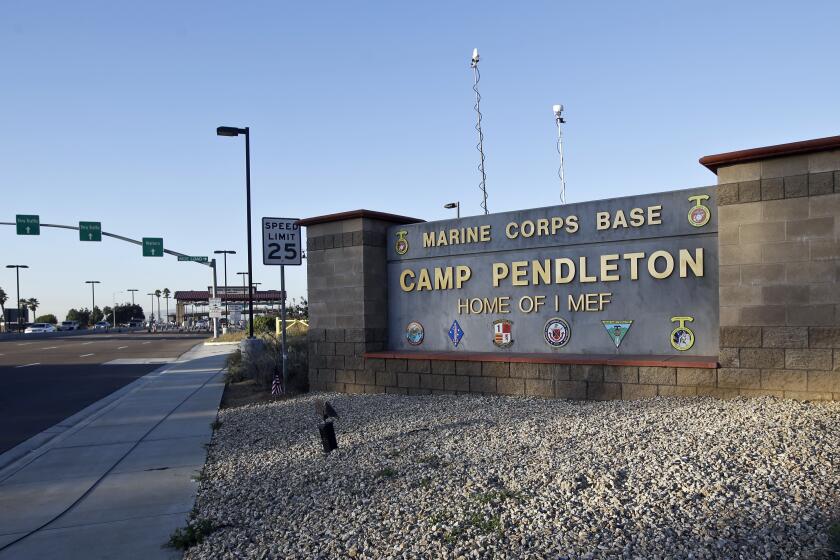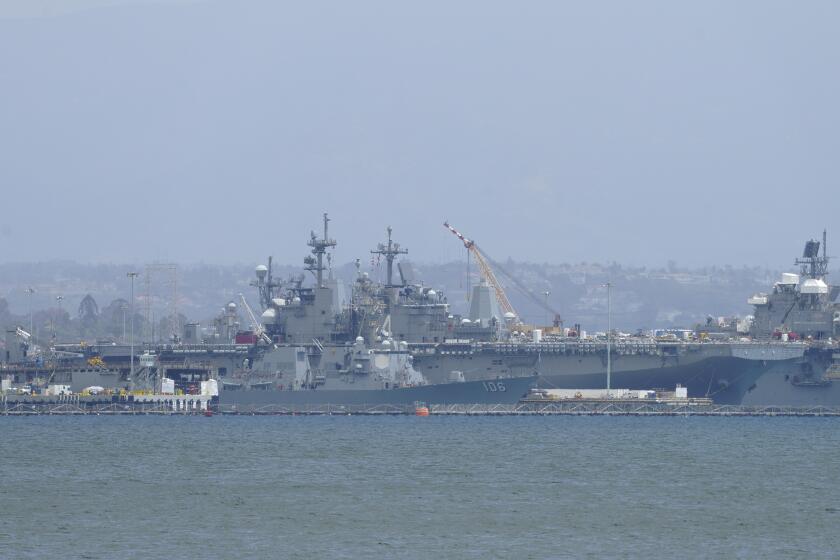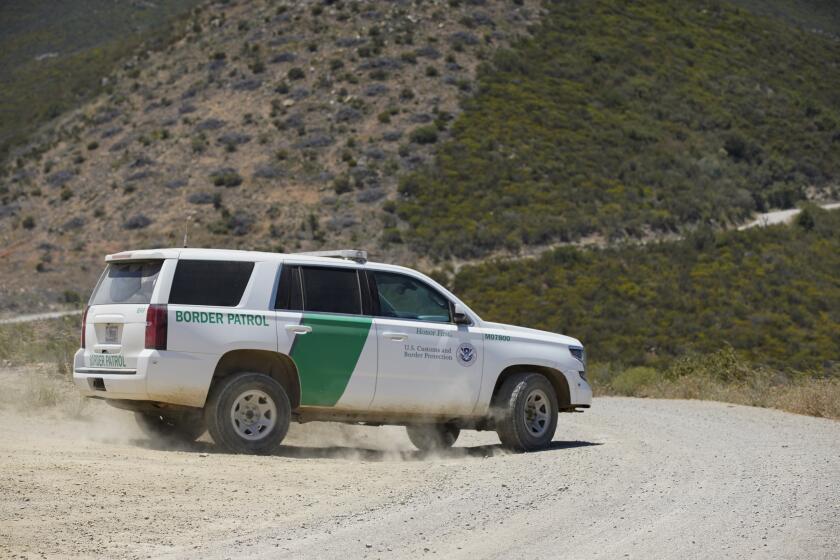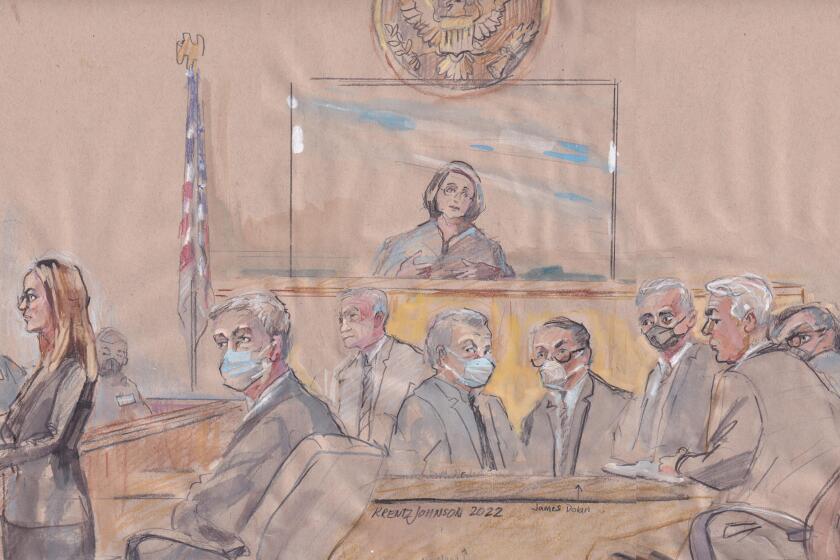Marine’s F-35B jet makes debut at Miramar Air Show
Spectators at the Miramar Air Show witnessed the end of an era in Marine aviation and a beginning, when a helicopter that served in the Vietnam War flew its last active duty performance and a stealthy, supersonic F-35B fighter jet flew its San Diego debut.
The CH-46 Sea Knight helicopter is being retired from Marine Corps service and replaced by the MV-22 Osprey tilt-rotor, which can fly faster and farther carrying more weight. The Marine Corps’ last operational squadron of the 1960s-era helicopter will be re-designated this month, making Camp Pendleton-based Marine Medium Helicopter Squadron 364 an Osprey squadron.
One of the snub-nosed, tandem rotor CH-46s, also affectionately called the “Battle Phrog,” was painted in Vietnam-era glossy green. As it flew ahead of three others in standard gunmetal gray, the Marine announcer said the historic aircraft was a tribute to veterans from that long-ago war, eliciting whoops and applause Saturday.
The F-35B Lightning II, the Marine variant of the Joint Strike Fighter under development by lead contractor Lockheed Martin for three services, later demonstrated its ability to hover and land at speeds of just 60 mph on a relatively short strip of runway.
The Corps created the Pentagon’s first operational squadron of F-35 planes in 2012. Yuma-based Marine Fighter Attack Squadron 121 has since flown more than 1,000 sorties totaling about 1,700 flight hours.
The Marine Corps said its plan to become the first service to declare initial operational capability for the jet, in July 2015, is on track despite the temporary grounding of the entire F-35 fleet this summer because of an engine malfunction in the Air Force version.
“This is the most advanced and newest fighter aircraft in the world. … the future of Marine aviation,” Col. John Farnam, commanding officer of Marine Corps Air Station Miramar, said in opening remarks.
F-35 fighter jet
The F-35 and the CH-46 are bookends for the overhaul underway of virtually the entire Marine aviation fleet. The CH-53 Super Stallion, UH-1 Huey and AH-1 Super Cobra helicopters, as well as KC-130 Hercules planes, are being upgraded.
The Corps intends the F-35B to eventually replace its AV-8B Harrier jump jets and F/A-18 Hornet fighter jets. But the Joint Strike Fighter Program has been dogged by cost overruns and delays, as well as the unsavory distinction during lean economic times of being the most expensive Pentagon weapons program ever.
The latest estimated cost for 2,457 aircraft is $332.3 billion, according to the 2014 annual arms report by the Government Accountability Office.
Lt. Col. Steve Gillette, commanding officer of the F-35 squadron, said they have all 16 jets and a full-strength complement of 280 personnel. In September the squadron began flying specific requirements to prepare for initial operational capability.
The service is dependent on delivery from Lockheed Martin of 2B software before it can declare the jet ready for combat, but Gillette said reports from the Joint Program Office leave the service very confident about its timeline.
“It’s not the full capability … but we will have weapons integrated, we will have combat capability. And the Marine Corps is raising its hand, saying ‘combatant commanders and Mr. President, … it’s available,” said Gillette, 42, of Lincoln, Neb.
In Yuma and Twentynine Palms the “Green Knights” have been flying in large scale combat exercises, dropping simulated ordnance and making vertical landings.
They currently are restricted to flying at 450 knots. With 2B software the speed limit rises to 550 knots, they can drop live ordnance, and the flight envelope opens to a greater angle of attack and G-loads.
Under full capability, the F-35B will sustain 7 Gs, compared to 9 for the Air Force version.
Gillette said the jet is easy to fly, requiring only six simulator or other training events for a pilot to learn to hover, versus nearly 30 in a Harrier. Even former F/A-18 Hornet pilots like himself with no experience in hover find it relatively simple, he said.
“Just in the infancy of the F-35 the state-of-the-art sensors and the software that drives those sensors is amazing to see from the cockpit perspective.”
The novelty for the Marine Corps and most of the Air Force is the stealth capability.
“How you fight a fifth-generation airplane that has stealth is very different than how you fly an F-18. There are certain threats that are out there, whether surface-to-air missiles or enemy fighters, that in an F-18 you have to make assumptions that they have very capable radars, so they always see you.
“It’s a very new and at first kind of uncomfortable feeling that you can get close to something that in a previous life was very lethal,” he said.
CH-46 Sea Knight helicopter
Farnam, the air station commander, said the venerable CH-46 “has been the backbone of Marine medium lift helicopters since the 1960s. It was spectacular when it was developed and … spectacular today.”
Aircraft 19, the one painted in historic colors and flown in the Miramar Air Show, has more than 14,000 flight hours on its frame since it was introduced in 1967. At one point it had hundreds of bullet holes from its Vietnam War service, but no trace remains of the Pepsi can patches the Marines once used in that war zone for repairs.
A Marine veteran and pilot named Pat Donovan earned two Navy Crosses flying casualty evacuation missions in this aircraft in 1969. “Then his daughter as a 46 pilot flew that very same aircraft on the 40th anniversary of that mission. And the aircraft is still here in the squadron,” noted Lt. Col. John Field, commanding officer of Marine Medium Helicopter Squadron 364.
The helicopter is one of two remaining with the squadron. After the air show one heads to the bone yard and the other will eventually be installed next year in the Smithsonian Museum in Washington, D.C.
The CH-46 is famous for evacuating the U.S. embassy during the fall of Saigon in 1975. Since then it has flown in every major Marine engagement.
“Just being part of this legacy is a very powerful honor. This aircraft has done more than what was planned for it,” said Maj. Eric Landblom, 41, of Dickenson, N.D., who piloted the historic aircraft during the air show.
The former infantry rifleman deployed three times to Iraq to fly casualty evacuation missions with the “Purple Foxes” squadron. Those were the most difficult and most rewarding moments of his military career, he said.
“Just by looking at your log books and how many busy days you had … you realize how many of those single missions added up to a fairly good-sized population of people who you contributed to saving their lives. Saving eyes, limbs,” he said.
Saying goodbye to the CH-46 is bittersweet, said Field, 44, of Virginia Beach, Va. “The machine changes, but the Marines are still going to do the same mission, whether it’s 46s in Vietnam or Ospreys in places to be named later, carrying that culture and that legacy into the new airframe.”
Miramar Air Show 2014
Get Essential San Diego, weekday mornings
Get top headlines from the Union-Tribune in your inbox weekday mornings, including top news, local, sports, business, entertainment and opinion.
You may occasionally receive promotional content from the San Diego Union-Tribune.





